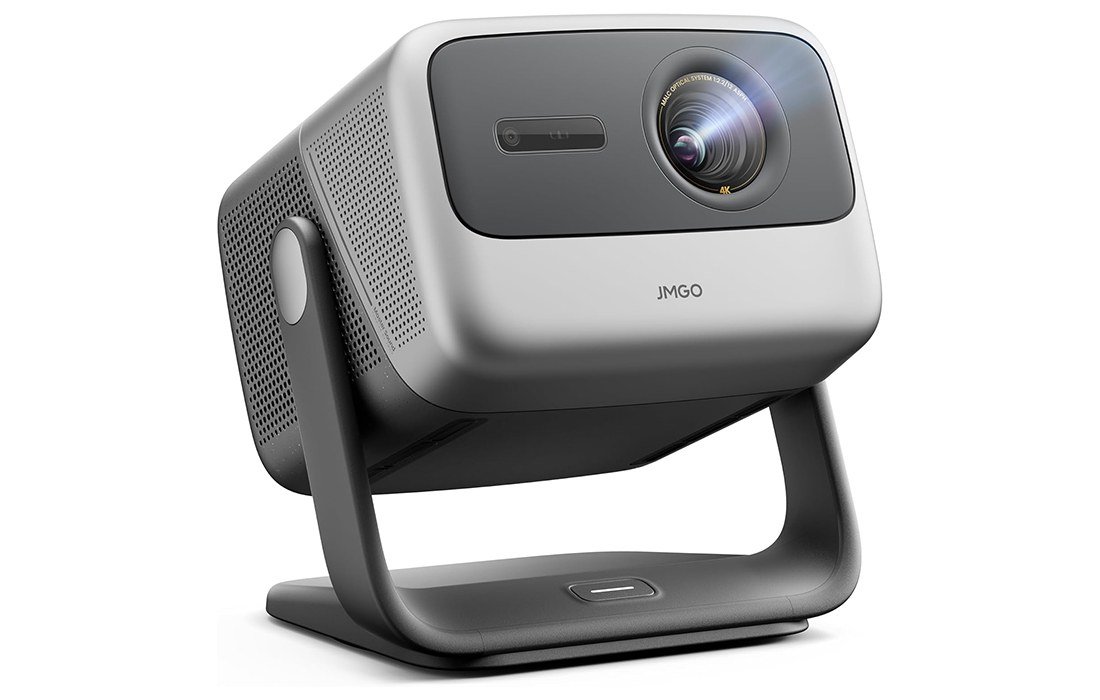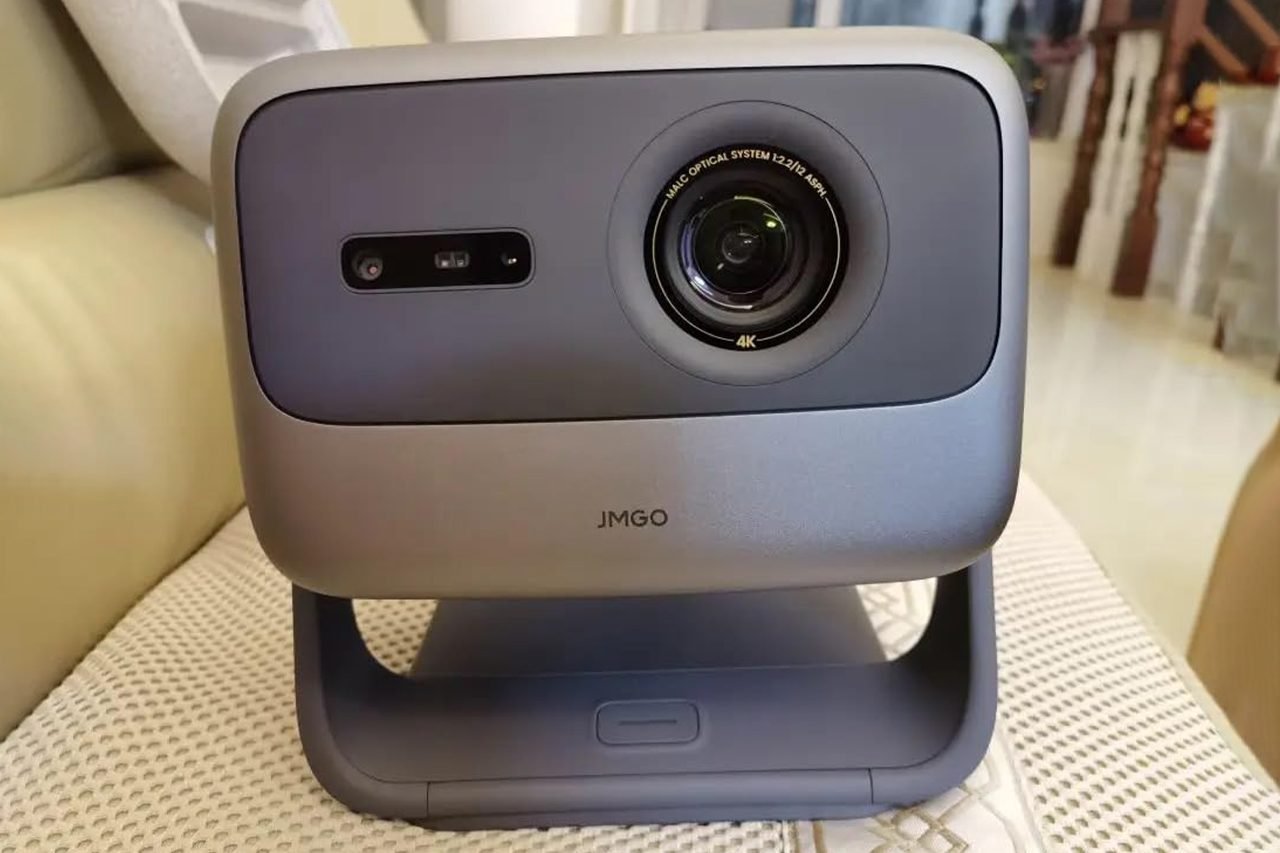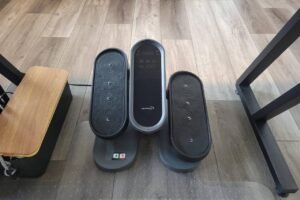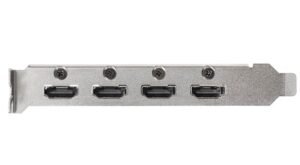
JMGO N1S Pro Projector — True 4K Triple-Laser for Big-Screen Nights
Our take: vivid triple-laser color, 2250 ISO-lumen brightness, and TV-grade Google TV with Netflix make this the easiest path to a 300″ cinema.
- RGB triple-laser true 4K with 110% BT.2020 & HDR10; 2250 ISO-lumen punch keeps colors bright in living rooms.
- Google TV with certified Netflix & Chromecast; real-time AF/keystone, screen fit, wall-color & brightness auto, plus gimbal placement.
- HDMI 2.1 (eARC) with ALLM and ~17ms input lag; dual 20W Dolby Digital Plus speakers with 45Hz bass.
- Brightness
- 2250 ISO lm
- Resolution
- 3840×2160 (True 4K)
- Color Gamut
- 110% BT.2020
- Gaming
- HDMI 2.1 eARC • ~17ms
The home-theater projector market has exploded with compact, laser-powered models that promise TV-like convenience and cinema-class pictures. JMGO’s N1S Pro is one of the most fully loaded examples: a true-4K, pure triple-laser DLP projector that folds an integrated motorized gimbal, certified Google TV with official Netflix, and a stout Dolby Digital Plus speaker system into a single carry-anywhere cube. On paper, it looks like a lifestyle projector that finally doesn’t ask you to compromise on picture quality.
At its core, the N1S Pro is built around an RGB pure triple-color laser light engine and a 0.47-inch DLP imaging chip to produce genuine 3840 × 2160 resolution. JMGO quotes 2,250 ISO lumens, 110% BT.2020 color gamut, 1600:1 FOFO (full on/full off) contrast, HDR10 decoding, and a 300-inch maximum image size. It’s designed to be flexible: the aluminum gimbal lets you tilt, swivel, and aim without a tripod; autofocus, auto-keystone, auto-screen fit, object avoidance, lossless zoom, and wall-color adaptation clean up geometry and color for you. A smart brightness auto-adaptation routine and eye-protection shutter round out the “set-it-down and watch” ethos.
JMGO is a brand that has leaned into laser projection for years, and the N1S Pro shows that heritage. Compared with many lifestyle rivals that mix laser with phosphor or LED, the N1S Pro’s pure triple-laser engine aims for richer color volume and better brightness retention. Inside, a MediaTek flagship video SoC (MT96xx class, commonly referenced as MT9669) handles Google TV, upscaling, and motion smoothing (MEMC), backed by 4GB RAM and 64GB storage for apps. Add HDMI 2.1 with eARC and ALLM, 17ms input lag, 4K/240Hz transmission, Blu-ray 3D support, Bluetooth 5, USB-A, and a 3.5mm headphone jack, and you have a compact cinema that doubles as a gaming display and smart streaming hub.
Is JMGO N1S Pro for you?
If your living room moonlights as a movie lounge and you want a projector that behaves like a smart TV—turn it on, open Netflix, and go—the N1S Pro is squarely aimed at you. Certified Google TV with official Netflix is still rare in projectors, and eliminating the sideloading/Workarounds™ dance is a real quality-of-life win. The projector’s auto-everything—focus, keystone, screen fit, wall-color and brightness adaptation, object avoidance, and eye-protection—makes it a terrific choice for casual, multi-use spaces where you can’t fuss with a screen every night.
Gamers also get a lot here. With HDMI 2.1, ALLM, 17ms low latency, and 4K/240Hz transmission (for consoles that output high-frame-rate signals), the N1S Pro feels responsive. The integrated 20W × 2 speakers with Dolby Digital Plus and 45Hz deep-bass extension give you credible sound without an immediate soundbar purchase, while eARC lets you add a serious system later.
It’s not for everyone, though. As a triple-laser DLP, the N1S Pro prioritizes color vibrancy and brightness over absolute theater-class black levels. If you have a light-controlled, velvet-bat-cave room and you obsess over OLED-like blacks, you may want a different class of projector or an ALR screen to further manage ambient light. Likewise, purists who prefer ultra-short-throw (UST) placement on a TV console may prefer a UST model; the N1S Pro is a standard-throw portable—brilliantly flexible, but it still needs room between lens and screen.
Budget-wise, this sits in the upper-mid to premium bracket for lifestyle projectors, justified by the laser engine, Google TV licensing, Netflix certification, audio hardware, and gimbal mechanics. For beginners, yes—it’s beginner-friendly. The automatic setup routines, built-in apps, and quick tilt-and-aim gimbal make it one of the least intimidating paths into large-screen viewing.
What We Like About the JMGO N1S Pro
The standout is picture vibrancy. Laser projectors live and die by color volume, and the N1S Pro’s claim of 110% BT.2020 gamut translates into lush, high-saturation images without the pastel wash that plagues lamp and many LED models. HDR10 titles showcase crisp specular highlights, while the 1600:1 FOFO contrast and triple-laser punch give sunsets, galaxies, and city nightscapes real pop. Crucially, the 2,250 ISO-lumens spec is stated in ISO rather than vague “LED lumens,” so brightness expectations map better to real rooms.
Convenience is the other headline. The gimbal is a masterstroke: instead of stacking books or fiddling with tripods, you tilt and swivel until the picture lands where you want it. Real-time autofocus and auto-keystone lock geometry quickly; auto screen fitting and object avoidance are genuinely useful in apartments where wall outlets, picture frames, or light switches intrude on the projection area. Wall-color adaptation gets you shockingly close to neutral whites on off-white paint, and brightness auto-adaptation saves you from menu diving when lighting changes.
Sound quality is far better than you expect in a portable. The dual 20-watt drivers and Dolby Digital Plus decoding deliver a wide, room-filling presentation with intelligible dialogue and enough bass to make soundbars optional—at least early on. When you outgrow it, eARC on HDMI 2.1 gives you bit-perfect audio to a receiver or Atmos bar with one cable.
Finally, smart features feel TV-grade. Google TV with 10,000+ apps, Chromecast built-in, Google Assistant voice control, and official Netflix remove the friction you often face with projectors. Startup is quick, app switches are smooth, and storage (64GB) means you can keep multiple streamers, games, or utilities installed without micro-managing space.
What We Don’t Like About the JMGO N1S Pro
First, black levels. While the N1S Pro’s triple-laser vibrancy and mid-native contrast produce exciting HDR, it is still a single-chip DLP with FOFO 1600:1. In dark, fully light-controlled rooms, letterbox bars won’t look inky the way they do on a high-end LCoS or OLED. Use an ALR screen or add bias lighting if black floor matters to you.
Second, port selection is good, not great. You get two HDMI 2.1 ports (one with eARC), one USB-A 2.0, and a 3.5mm jack. That’s fine for a streamer + console + drive, but creators might miss a USB-C input or higher-speed USB-A. The HDMI ports are rear-facing, which is tidy on a table but a little tight if you’re frequently plugging in laptops.
Third, laser speckle and DLP artifacts can appear with certain content or surfaces. The N1S Pro avoids a color wheel (so no classic rainbow effect from spinning segments), but on high-contrast edges you may still notice micro-speckle or DLP shimmer at short viewing distances. It’s minor for most viewers, yet worth noting.
Finally, while the auto features are excellent, any aggressive keystone correction reduces effective resolution if overused. The image looks best when you can aim mostly straight and let the gimbal do the geometry rather than relying on heavy digital keystone.
Pros & Cons
| Pros | Cons |
|---|---|
| True 4K DLP with RGB triple-laser light source; 110% BT.2020 color | Native black levels are good for DLP but not “theater-class” |
| 2,250 ISO lumens for credible daytime and backyard viewing | Port layout is limited to 2× HDMI 2.1 + 1× USB-A; no USB-C |
| Google TV with official Netflix, Chromecast, Assistant | Laser speckle / DLP shimmer can be visible to sensitive viewers |
| Real-time AF/keystone, auto screen fit, object avoidance, wall-color & brightness adaptation | Heavy keystone reduces crispness—use the gimbal whenever possible |
| Integrated gimbal for effortless placement | To unlock best blacks/contrast you still want lights dimmed or an ALR screen |
| HDMI 2.1 (eARC), ALLM, ~17ms low-lag gaming, 4K/240Hz transmission | Only one USB-A 2.0; local media power users may want more |
| Dual 20W speakers with Dolby Digital Plus and 45Hz bass | 3D support is Blu-ray 3D; streaming 3D remains limited |
| Quiet operation (~28 dB) |
What’s Included?
- JMGO N1S Pro projector
- Power adaptor
- Remote control
- Batteries for remote
- User manual and documentation
As portable projectors go, the pack-ins are solid. The remote is the only accessory you truly need because Google TV handles virtually all streaming without a dongle. We would have loved an included soft case for travel, and 3D glasses are not part of the bundle (understandable given the niche), but the out-of-box experience is clean and quick. You can unbox, sign into Google, and be watching within minutes.
Technical Specifications
| Category | Spec |
|---|---|
| Display Technology | DLP with RGB pure triple-laser light engine |
| Native Resolution | 3840 × 2160 (True 4K) |
| Brightness | 2,250 ISO lumens |
| Color Gamut | 110% BT.2020 |
| Contrast | 1600:1 FOFO (dynamic up to 2,000,000:1 as marketed) |
| HDR | HDR10 decoding; MEMC motion interpolation |
| OS | Google TV (10,000+ apps), certified Netflix |
| CPU / Memory | MediaTek MT9669-class SoC; 4GB RAM / 64GB storage |
| Gaming | HDMI 2.1, ALLM, ≈17ms low latency, 4K/240Hz transmission |
| Audio | Dual 20W speakers, Dolby Digital Plus; 45Hz low-frequency extension |
| Connectivity | 2× HDMI 2.1 (one eARC), 1× USB-A 2.0, 1× 3.5mm headphone; Bluetooth 5 |
| Throw / Image Size | Minimum throw ~5.2 ft for 60"; max image up to 300" |
| Auto Adjustments | Autofocus, Auto Keystone, Auto Screen Fit, Object Avoidance, Brightness Auto-Adapt, Wall-Color Adaptation, Lossless Zoom, Smart Eye Protection |
| Noise | As low as 28 dB |
| Light Source Life | Up to 30,000 hours (manufacturer claim) |
| Power | ~180 W |
| Form Factor | Portable tabletop with integrated gimbal |
| Supported 3D | Blu-ray 3D |
| Compatible Devices | Consoles, laptops, smartphones, tablets, speakers, USB drives |
Specifications are based on manufacturer-provided information and may vary by region or firmware.
Features
- Pure triple-laser engine (no color wheel): maximizes color volume and brightness retention while reducing color breakup artifacts.
- True 4K resolution at the imager: delivers crisp detail and text clarity for movies, games, and sports.
- 2,250 ISO-lumens brightness: a meaningful brightness standard that holds up better in moderately lit rooms and backyard screenings.
- 110% BT.2020 color: among the widest color coverage in its class, enabling vivid HDR tones and rich primaries.
- 1600:1 FOFO contrast (up to 2,000,000:1 dynamic): deepens perceived depth while preserving highlight pop.
- HDR10 + MEMC: handles high-dynamic-range content and offers optional motion smoothing for sports.
- Google TV with official Netflix: frictionless access to 10k+ apps, Chromecast, Assistant voice.
- Integrated gimbal: fast, stable aiming without a tripod; ideal for room-to-room portability.
- Auto focus / keystone / screen fit / object avoidance: true one-touch setup in imperfect rooms.
- Wall-color and brightness adaptation: compensates for non-white walls and changing ambient light.
- Lossless zoom: resize the image to fit frames or to avoid obstacles without softening the picture.
- HDMI 2.1 with eARC and ALLM, ≈17ms latency: console-friendly, bit-perfect audio out.
- Dual 20W Dolby Digital Plus speakers with 45Hz bass extension: unusually full sound for a portable.
- Blu-ray 3D support: still a rarity; great for legacy 3D disc collections.
- Quiet operation (~28 dB): fan noise fades into the background.
- Long light-source life (up to 30,000 hr): years of maintenance-free viewing.
Feature verdict. For a portable, the N1S Pro reads like a wish list checked off. The trio of true 4K, triple-laser color, and Google TV with Netflix puts it a tier above many lifestyle models that either sacrifice resolution, rely on uncertified Android forks, or ship without Netflix. The only caveats are the class-typical DLP black floor and a restrained I/O roster. If those aren’t deal-breakers, feature density here is outstanding.
Performance Deep-Dive
Picture Quality and Color
The defining trait of the N1S Pro is color confidence. The projector’s coverage of BT.2020 beyond 100% means wide-gamut titles—animated films, nature docs, neon-lit dramas—leap off the wall. Skin tones avoid the waxy anomalies you sometimes see with laser-phosphor engines because RGB lasers don’t require phosphor conversion that can skew spectral balance.
The triple-laser approach also helps maintain brightness in saturated scenes. Many lamp or LED projectors brighten whites well but lose steam when asked to display fully saturated reds or blues; by contrast, lasers drive those primaries more efficiently. The result is a picture that holds its punch in real content, not just on test patterns.
Where it can’t defy physics is absolute black level. DLP’s native contrast is improved by laser dimming and gamma controls, but in a dark cave you’ll notice letterbox bars as dark gray. The counter is to play to the laser’s strengths: lean into HDR highlights, vivid color, and large-screen immersion, and, if possible, pair the projector with an ALR screen or a lightly lit bias behind the viewing wall to raise the room’s black reference.
Brightness and Ambient Light
At 2,250 ISO lumens, the N1S Pro competes well in rooms with moderate ambient light. Curtains open on a cloudy afternoon? Still very watchable at 100–120 inches. For daytime sports with sun-splashed windows, you’ll want to reduce image size or close blinds. Outdoors after dusk, brightness is terrific up to 150–200 inches; for a theatrical 300-inch setup, darkness is your friend.
JMGO’s brightness auto-adaptation is smarter than typical “eco/bright” toggles. It nudges output and gamma so you don’t blow out highlights when a cloud moves or a lamp turns on. Combined with wall-color adaptation, it makes casual viewing on a painted wall surprisingly satisfying.
Motion and Gaming
The projector supports MEMC motion smoothing. For films, many will prefer it off (to avoid the soap-opera effect), but for sports and live TV, the interpolation is competent without egregious artifacts. Input lag around 17ms in game mode is competitive for a projector, and the HDMI 2.1 pipeline with ALLM keeps consoles snappy. The 4K/240Hz transmission note is about link bandwidth—actual DLP refresh is lower—but it ensures clean handshakes with next-gen consoles and PCs.
Audio and Noise
Most portables force an immediate soundbar purchase; the N1S Pro doesn’t. The dual 20-watt array has enough body to carry a living room, and Dolby Digital Plus decoding improves streaming audio quality. Bass to ~45Hz is credible for an all-in-one; explosions have weight, and music avoids tinny harshness. If and when you want more, eARC simplifies the upgrade path to Atmos sound.
Cooling noise is whisper-quiet at about 28 dB, which disappears once content starts. Laser engines are efficient, and JMGO’s tuning keeps fan ramps gentle even during high-brightness scenes.
Setup, Placement, and Everyday Use
The gimbal is addicting. You set the projector on a table, twist the head toward the wall, and watch the picture settle into a rectangle. Auto focus snaps quickly; auto keystone and screen fit finish the frame. JMGO adds clever touches such as object avoidance—when a wall outlet or picture frame intrudes, the projector dynamically resizes to dodge it. Lossless zoom lets you trim the image to fit a screen border without scaling blur.
The smart layer is mature. Google TV is currently the best TV OS for app depth, recommendations, and cross-service search, and JMGO’s inclusion of official Netflix matters. Unlike many Android-based projectors where Netflix is missing or stuck in mobile mode, here it runs with proper certification. Chromecast makes casting from phones painless, and Assistant voice input streamlines navigation.
3D and Niche Use Cases
Blu-ray 3D support is rare but welcome for collectors. The triple-laser’s brightness helps. You’ll need compatible active-shutter glasses and a 3D-capable Blu-ray player; as usual, streaming 3D availability is minimal. For education or business, the N1S Pro’s brightness, portability, and quick setup make it an appealing hybrid device—movie nights at home, presentations during the day.
Unlock 4K Laser Cinema at Home
True 4K triple-laser • 2,250 ISO lumens • Google TV with Netflix • HDMI 2.1 eARC & ~17ms gaming.
Apply USN1SPRO & Check Live PriceSetup Tips and Best Practices
- Use the gimbal first, keystone second. Aim the chassis to minimize digital keystone; geometry corrections reduce pixel-level sharpness.
- Start with Standard or Cinema picture mode. Then fine-tune color temperature and gamma; avoid cranking laser brightness to max unless you truly need it.
- Enable ALLM for consoles. This locks in Game mode and minimizes processing to achieve ~17ms latency.
- Consider an ALR or gray screen. It raises perceived contrast in living spaces and tames black floor without sacrificing too much brightness.
- Pair with eARC when you upgrade audio. One HDMI cable to an Atmos bar or AVR keeps the setup tidy.
- Mind wall texture. Laser-sharp images reveal wall imperfections. A smooth projection paint or screen will reward the N1S Pro’s detail.
Competitor Context
Lifestyle projectors tend to force trade-offs: LED models are efficient and quiet but dim, while hybrid laser-phosphor systems boost brightness but shrink color volume. Against common competitors quoting ~1,800 ISO lumens or ~2,000 ANSI lumens, the N1S Pro’s 2,250 ISO lumens and 110% BT.2020 give it an edge in saturated HDR scenes and large outdoor images. Many rivals also lack official Netflix or run older Android TV builds with modest storage; JMGO’s Google TV + 64GB feels more like a streaming box inside a projector.
If your priority is absolute blacks in a theater cave, some LCoS-based projectors outperform the N1S Pro but lack its portability and smart integration. If you favor UST convenience on a TV stand, a UST laser with an ALR screen is another path—though at this price tier, you’ll often sacrifice either Netflix certification or color volume.
Reliability and Maintenance
Laser light sources are rated up to 30,000 hours, which—at four hours per night—translates to decades before appreciable dimming. There’s no lamp to replace. Keep vents clear, dust with compressed air occasionally, and install firmware updates through Google TV when prompted. Fan noise is already low; a well-ventilated shelf or table keeps it that way.
Who Should Buy It?
- Movie lovers who want cinematic color and HDR pop without sacrificing the convenience of Google TV and Netflix.
- Family rooms and shared spaces where the projector moves between rooms, outdoors, or to friends’ houses—the gimbal makes it drop-in simple.
- Gamers seeking low latency and HDMI 2.1 features on a huge screen.
- Small apartments and dorms, thanks to the compact cube design and strong built-in speakers.
Who should pass? Black-level purists with totally light-controlled rooms; port-heavy power users who need multiple USB inputs; and users who want UST placement specifically.
Final Breakdown
9.2 / 10
JMGO’s N1S Pro nails the lifestyle-meets-cinema brief. It’s the rare portable that doesn’t feel compromised: true 4K detail, triple-laser color volume, 2,250 ISO-lumen punch, and Google TV with certified Netflix in a design you can carry to the patio. Setup is nearly foolproof thanks to the gimbal and a full suite of auto adjustments. The speakers are robust enough for movie nights, yet eARC keeps the upgrade path wide open. For gaming and sports, ALLM and ~17ms latency keep the action crisp.
The compromises are the familiar DLP ones—black levels that are good rather than legendary, and a modest port selection. But taken as a whole, the N1S Pro is one of the most balanced, decisive picks in the premium portable class. If you want a projector that behaves like a modern smart TV yet scales up to 300 inches with sumptuous laser color, it belongs at the top of your shortlist.
Recommendation: Buy with confidence if you value vibrant color, official Netflix/Google TV, and painless setup in a portable form factor. Pair it with an ALR screen (or dim the lights) to extract the best contrast, and use the gimbal to keep keystone minimal. Do that, and you’ll get a big-screen experience that’s easy, bright, and genuinely cinematic.
| Preview | Product | Price | |
|---|---|---|---|
|
|
JMGO N1S Pro True 4K Triple Laser Projector, GTV, Netflix, 2250 ISO Lumens, Blu-ray 3D, Auto Focus,... |
$1,199.00
$1,019.00 |
View on Amazon |






